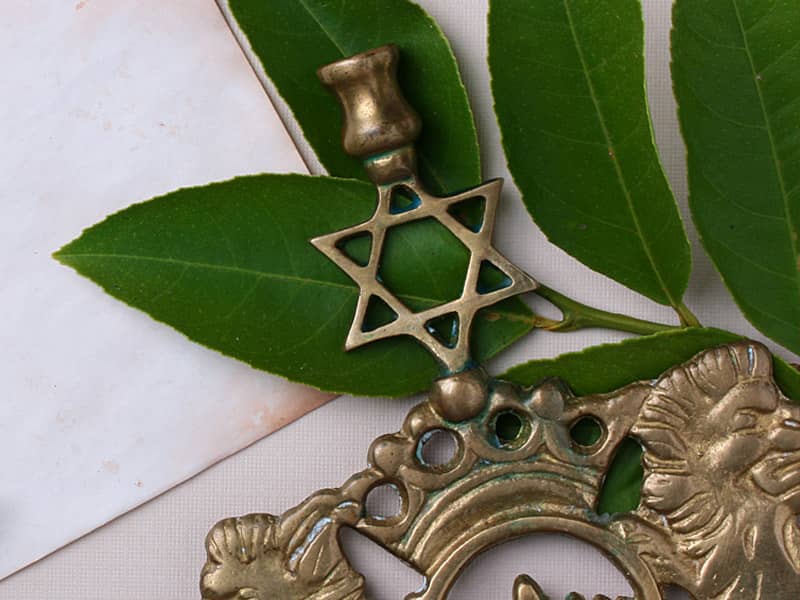What is the Omer, anyway, and what does it have to do with Passover? How long does the Omer last? And why does it start on the second night of Passover and not, say, the first?
The Omer is the 49-day period stretching from the second night of Passover to the start of Shavuot, marking the arduous path of spiritual enlightenment that begins with Passover's celebration of the redemption from Egyptian slavery and reaches its pinnacle with the giving of the Torah on Shavuot. It is marked by the daily ritual of counting the Omer, noting both the day and week (for example,"Today is 24 days, which is three weeks and three days to the Omer"). But like many other occasions on the Jewish calendar, the Omer period is one that has taken on a variety of meanings and associations with the passage of time. Like a capsule version of Judaism itself, the Omer and its customs contain multitudes ranging from the era of the Temple to the recent past.
The notion of the Omer stems from the biblical commandment to bring an offering to the Temple on the 16th of Nissan, the second day of Passover. Beginning on that day, the Torah states, one is required to count seven weeks, with the 50th and final day being Shavuot. Even in the absence of the Temple, and the Omer's ritual offering of the first of the harvest, the counting of the Omer abides.
The purpose of the counting of the Omer, and of the Omer itself, is actually a matter of some disagreement. The kabbalists saw the Omer as a strictly spiritual period, in which each day reflected a bump upward in holiness. This is balanced by the post-Temple understanding of the Omer as a period of mourning in which weddings, music, haircuts, shaving and other emblems of joy are strictly forbidden.
According to the Gaonim (the generation of scholars postdating the Talmud), the mourning is in response to the tragedy of the students of Rabbi Akiva, all 24,000 of whom mysteriously died in a plague that, as legend has it, stemmed from their internecine bickering. In remembrance of their fate, and in the hopes of avoiding their sin, the Omer is treated by many observant Jews as a period of solemnity, leading into the Three Weeks and the Nine Days, steps on the ladder leading to the saddest day on the Jewish calendar, Tisha b'Av, which commemorates the destruction of both Temples.
Anchoring the Omer, and providing a respite from its gravity, is Lag b'Omer (celebrated this year on May 27), which takes place on the cycle's 33rd day. According to the gaonic tradition, Lag b'Omer was the day on which the deaths of Akiva's students miraculously ceased. It is also considered to be the day that one Akiva's students, Rabbi Shimon bar Yochai, emerged from the cave in which he hid, and studied Torah, during the Roman occupation. Others see Lag b'Omer as symbolic of the 33 non-holy days (neither Sabbaths nor holidays) that occur between Passover and Shavuot. More iconoclastic scholars relate the 33-day period to the Roman custom of superstitious fear for 32 days—beginning the last day of April—owing to the presence of the wandering souls of the dead.
The disagreement about the meaning of Lag b'Omer also has led to a variety of modes of observance of the Omer itself; where most observant Jews observe the restriction of the Omer between Passover and Lag b'Omer, others do so on the 33 non-holy days between Passover and Shavuot, while others position the Omer between the first of Iyar and Shavuot—a period of 33 days.
Regardless, Lag b'Omer is a joyous occasion celebrated with bonfires and other merriment. Weddings are celebrated on Lag b'Omer, and the hirsute, and the fashion conscious, can get their hair cut. The mourning of the Omer is relaxed, and the heavy cloud of Jewish history's misfortunes is momentarily lifted for a day of enjoying its triumphs.
That these triumphs center on two of the great figures of the talmudic era should come as little surprise, for Judaism's longevity owes a great debt to the success of its scholars. If the Omer commemorates the calamities surrounding the destruction of the Temple, the central catastrophe of Jewish history until the Holocaust, then Lag b'Omer, however obliquely, honors the memory of the men, and the ideas, that kept Judaism alive in the face of disaster.

